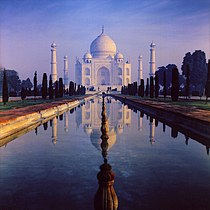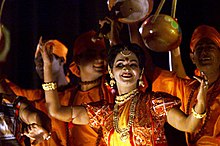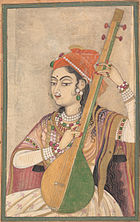Qawwali
| hide Part of a series on Islam Sufism |
|---|
 |
Originally performed at Sufi shrines or dargahs throughout South Asia, it gained mainstream popularity and International audience in late 20th century. Qawwali music received international exposure through the work of the late Pakistani singers Nusrat Fateh Ali Khan, Sabri Brothers, and Aziz Mian largely due to several releases on the Real World label, followed by live appearances at WOMAD festivals. Other famous Qawwali singers include Pakistan's Amjad Farid Sabri, Fareed Ayyaz & Abu Muhammad, Rahat Fateh Ali Khan, Badar Maindad, Rizwan & Moazzam Duo, Bahauddin Qutbuddin.
Contents
Origins of Qawwali[edit]
Qaul (Arabic: قَوْل) is an "utterance (of the prophet)", Qawwāl is someone who often repeats (sings) a Qaul, Qawwāli is what a Qawwāl sings.
Song content[edit]
| showMusic of Pakistan |
|---|
| showMusic of Bangladesh |
|---|
| showMusic of India |
|---|
 |
| Part of a series on |
| Islamic culture |
|---|
| Architecture |
| Art |
| Dress |
| Holidays |
| Literature |
| Music |
| Theatre |
The poetry is implicitly understood to be spiritual in its meaning, even though the lyrics can sometimes sound wildly secular, or outright hedonistic. The central themes of qawwali are love, devotion and longing (of man for the Divine).
Qawwalis are classified by their content into several categories:
- A hamd (حمد), Arabic for praise, is a song in praise of Allah. Traditionally, a qawwali performance starts with a hamd.
- A na`at (نعت), Arabic for description, is a song in praise of Muhammad. The opening hamd is traditionally followed by a naat.
- A manqabat (plural manaqib, مناقب, which means characteristics) is a song in praise of either Imam Ali or one of the Sufi saints. Manaqib in praise of Ali are sung at both Sunni and Shi'a gatherings. If one is sung, it will follow right after the naat. There is usually at least one manqabat in a traditional programme.
- A marsiya (مرثية), Arabic for lamentation for a dead person, is a lamentation over the death of much of Imam Husayn's family in the Battle of Karbala. This would typically be sung only at a Shi'a gathering.
- A ghazal (غزل), Arabic for love song, is a song that sounds secular on the face of it. There are two extended metaphors that run through ghazals—the joys of drinking and the agony of separation from the beloved. These songs feature exquisite poetry, and can certainly be taken at face value, and enjoyed at that level.[5] In fact, in Pakistan and India, ghazal is also a separate, distinct musical genre in which many of the same songs are performed in a different musical style, and in a secular context. In the context of that genre, the songs are usually taken at face value, and no deeper meaning is necessarily implied. But in the context of qawwali, these songs of intoxication and yearning use secular metaphors to poignantly express the soul's longing for union with the Divine, and its joy in loving the Divine. In the songs of intoxication, "wine" represents "knowledge of the Divine", the "cupbearer" (saaqi) is God or a spiritual guide, the "tavern" is the metaphorical place where the soul may (or may not) be fortunate enough to attain spiritual enlightenment. (The "tavern" is emphatically not a conventional house of worship. Rather, it is taken to be the spiritual context within which the soul exists.) Intoxication is attaining spiritual knowledge, or being filled with the joy of loving the Divine. In the songs of yearning, the soul, having been abandoned in this world by that cruel and cavalier lover, God, sings of the agony of separation, and the depth of its yearning for reunion.
- A kafi is a poem in Punjabi, Seraiki or Sindhi, which is in the unique style of poets such as Sultan Bahoo, Shah Hussain, Bulleh Shah and Sachal Sarmast. Two of the more well-known Kafis include Ni Main Jana Jogi De Naal and Mera Piya Ghar Aaya.
- A munajaat (مناجاة), Arabic for a conversation in the night or a form of prayer, is a song where the singer displays his thanks to Allah through a variety of linguistic techniques. It is often sung in Persian, with Mawlana Jalāl-ad-Dīn Rumi credited as its author.





Comments
Post a Comment